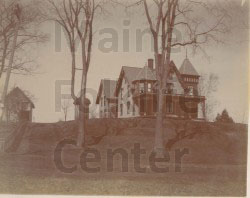Eddington, “The Cambric Shirt”
Song: “The Cambric Shirt”
Singer: Jennie Gray
Town: Eddington, ME
ID: NA0183 CD 24 Track 10
Collected By: Evelyn Huckins
Date: 1961
Child: 2
Roud: 12
“The Cambric Shirt” is one of the many British ballads chronicled by Francis James Child in the late nineteenth century. The song is titled “The Elfin Knight” in Child’s collection, and “The Cambric Shirt” is one of many names of the many variations on the song. As Tristam P. Coffin noted, there are a few basic story types within the variations of the song. The first version contains an actual story in which a man imposes tasks upon a woman, who will be acquitted of them and get her lover if she can answer with tasks of equal difficulty. The second version, which is one heard here, does not contain the story, but clearly sets forth the challenges and answers. A third major variation further degenerates into nonsense with only the order to make a cambric shirt remaining. Three versions of the song (again labeled as “The Elfin Knight”) collected in Maine appeared in British Ballads from Maine by Barry, Eckstorm, and Smyth. Of the three, the “A” version, collected in Brewer (Eddington’s neighbor to the southwest) and known to the singer as “Redio-Tedio,” was the most similar to Mrs. Gray’s version. Barry et al noted “Redio-Tedio” as a “most unusual version” of the song and a “distinct addition to the many variants” of the song. “The Cambric Shirt” was not a popular woods song, and the version sung here by Mrs. Jennie Gray was likely passed down to her through family tradition. It was not popular in the woods because of the song’s long history: it is one of the great ballads to come from Europe and over time it developed into a children’s song, as it was known to Jennie Gray and her contemporaries.
What, then, is a cambric shirt? Cambric is a type of finely woven cotton or linen cloth that is specially treated to create a glossy, stiff appearance. It was popular from the sixteenth to nineteenth centuries, especially for fine embroidery, but does not stand up to extended wear and is thus now difficult to find. However, a type of cambric known as chambray is still widely used for shirts.
Lyrics:
1.
“Say, young man, are you going to the fair?
Fum a lum a lye fum a lye lo lee
And if you see my true love there,
Timmy hiddle-o a diddle-o, fum a dum a diddle-o
Fum a lum a lye fum a lye lo lee.
2.
“Tell her to make me a cambric shirt
Without a stitch of needle work.
3.
“Tell her to wash it in a dry well
Where never a drop of water fell.
4.
“Tell her to hang it to dry on a thorn
That never had a thorn since Adam was born.”
5.
“Say, young lady, are you going to the fair?
And if you see my true love there,
6.
“Tell him to buy me an acre of land
Between salt water and sea sand.

7.
“Tell him to plow it with a ram’s horn
And seed it down with a peck of corn.
8.
“Tell him to cut it with a peacock’s feather,
And bind it up with the sting of an adder.
9.
“Haul it in on the back of a snail
And thrash it out with a mouse’s tail.
10.
“Tell this fool when he’s done with his work
To come and get his cambric shirt.”
Sources: Ives, Edward D., ed. “Folksongs from Maine,” Northeast Folklore, VII (1965), 87-89; Child, Francis James, ed. The English and Scottish Popular Ballads. Vol. I. New York: Dover Publications, 1965, 6-19 (C2); Peacock, Kenneth. Songs of the Newfoundland Outports. Vol. I. Ottawa: National Museum of Canada, 6-8; and Coffin, Tristam P. The British Traditional Ballad in North America. Philadelphia: The American Folklore Society, 23-24.
